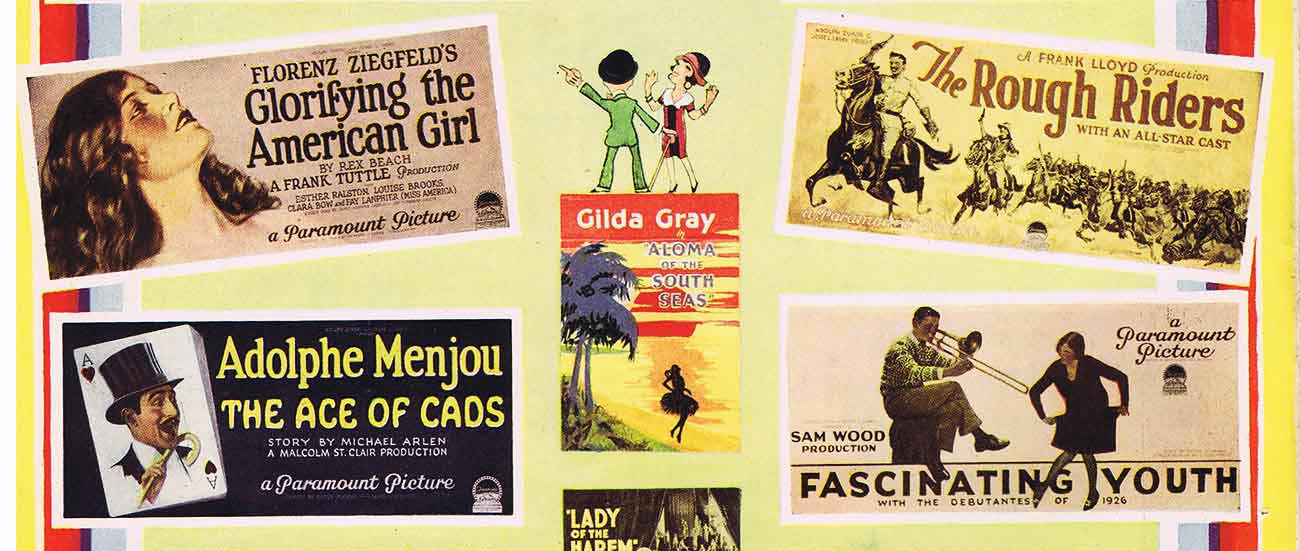Movies were an art form that captured the interest of the masses worldwide. As a new form of entertainment their success was extremely rapid. They entertained and made people laugh, making the world a happier place to live in after the horrors of WW1.

Silent movies dominated until the late 1920s
The 1920's movie goers experience was largely dominated by silent movies but saw the introduction of synchronized sound.
In the 1920's movie stars were really stars - with huge salaries, the fashions and activities of the Hollywood greats echoed around the world and 100,000 people would gather in cities all over the world, including such diverse cities as London and Moscow, to greet Mary Pickford and Douglas Fairbanks when they toured of Europe.

Early silent movies were often accompanied by live piano or organ music and provided enormous entertainment value to audiences captivated by the experience of watching moving pictures on the silver screen. Although the had been previous attempts to introduce sound, it wasn't until 1923 that a synchronised sound track was photographically recorded and printed on to the side of the strip of motion picture film and made it on to a commercially distributed movie. It would still be seven long years before talking pictures gained total supremacy and finally replaced the silent film era.
The first movie theatres were called Nickelodeons, and were very basic compared the luxurious picture palaces that followed but what an aura of excitement, of laughter, fun and tears surrounded them! Before the introduction of movie soundtracks, movies were often accompanied by scripted music from a piano. Pearl White was the damsel in distress, Francis X. Bushman had lots of adoring female admirers, Theda Bara wrecked homes, Charlie Chaplin and Fatty Arbuckle and Mack Sennett set crazy standards, never to be improved on, and a collection of beautiful ladies adorned the screen. The male and female movie stars were idolized world-wide by adoring fans who could never get enough of them.
Blue laws which were originally introduced in 1790 to restrict entertainment and sabbath breaking activities on Sundays were applied randomly to stop movie theaters opening on Sunday in some jurisdictions while allowing them in other places - New Jersey is a case in point. While the blue laws were supported by churches, most business people and politicians were against them being used to restrict Sunay picture shows.
The production of The Jazz Singer in 1927 did much to change the industry's perception of talking pictures. The technology had advanced little in the previous five years, but the production was the first feature length talking picture to feature a star singer and actor, Al Jolson, speaking and singing on screen. The huge demand for The Jazz Singer was unexpected, and caused other studios tobegin to produce sound films of their own to capitalize on what at the time they saw as a fad.
1927 was the year when research into synchronized sound started to pay-off and new talking-picture technologies saw the light of day. The Warner Bro's Vitaphone sound–on–disc system was used for "The Jazz Singer". Vitaphone competitors, "Movietone" sound-on-film by Western Electric, and "Photophone" by RCA were also developed at this time.

By 1927 Hollywood had become the center of movie-making in the U.S. with 85% of U.S. movie production occurring in or around Hollywood. Good weather and a wide variety of scenic locations were factors in its success. Whole new industries grew in conjunction with the movie business including zoos and animal supply companies, costume suppliers, and casting agencies. The huge output of U.S. movie studios overwhelmed film production in other countries causing problems with France in particular.
The huge Metro-Goldwyn-Mayer studio was founded by Samuel Goldwyn and Louis B. Mayer in 1924.
The 1920s represented the era of greatest film output in the US movie market. An average of 800 films were produced annually. Although developments in color and sound were still at the experimental stage, a strong demand for movies, and the opportunity to make money, encouraged studios to produce "talkies" for commercial release.
Rudolph Valentino and Charlie Chaplin rose to stardom in this era, which also saw the premier of the first Walt Disney animated cartoon and the debut of Mickey Mouse.
Once silent movies gave way to talking pictures the issue of profanity was raised. The anti-war play (also made into a movie), "What Price Glory?", was the first to use bad language in a realistic representation of World War 1 soldiering. What the authors of that play set down in bitter revolt against war, then started to be accepted as the necessary vehicle of any and every phase of dramatic composition. The debate on realism and bad language has endured to the present day with profit increasingly put ahead of common decency.
In what is perceived as an indication of racial tolerance, MGM released the African-American sound feature film, “Hallelujah” in 1929.
The French model of commercial movie houses became the international model, and entrepreneurs scurried to build impressive movie houses across North America and Europe including theatres to seat up to 5,000 people. The Capitol Theater in New York City seating 8,000, became the biggest cinema in the world in 1921. Oscar Deutsch opened his first Odeon cinema in the UK in 1920. By 1930 the Odeon was a household name and still thrives today across Britain with a vast array of purpose built cinemas.
By the end of the 1920s the silent movie era was over, although the last one was not released until 1931 - See the 1920s Movie Timeline
1920s MOVIE RESOURCES
Charlie Chaplin Posters and DVD's
Buy Charlie Chaplin Posters and DVDs Online
1920s MOVIE POSTERS
Vintage Movies



